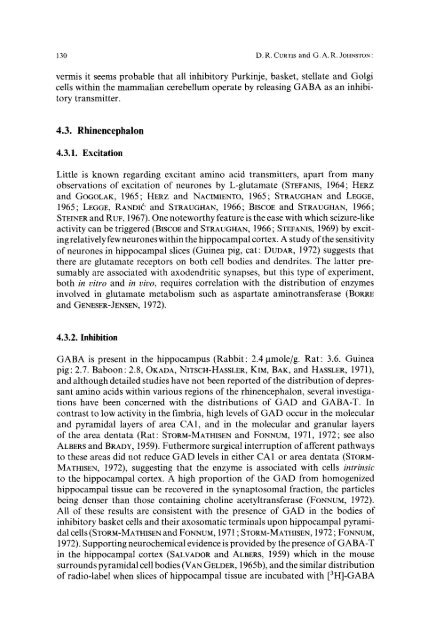Amino acid transmitters in the mammalian central nervous system
Amino acid transmitters in the mammalian central nervous system
Amino acid transmitters in the mammalian central nervous system
Create successful ePaper yourself
Turn your PDF publications into a flip-book with our unique Google optimized e-Paper software.
130 D.R. CURTIS and G. A. R. JOHNSTOY :<br />
vermis it seems probable that all <strong>in</strong>hibitory Purk<strong>in</strong>je, basket, stellate and Golgi<br />
cells with<strong>in</strong> <strong>the</strong> <strong>mammalian</strong> cerebellum operate by releas<strong>in</strong>g GABA as an <strong>in</strong>hibitory<br />
transmitter.<br />
4.3. Rh<strong>in</strong>encephalon<br />
4.3.1. Excitation<br />
Little is known regard<strong>in</strong>g excitant am<strong>in</strong>o <strong>acid</strong> <strong>transmitters</strong>, apart from many<br />
observations of excitation of neurones by L-glutamate (STEVANIS, 1964; HERZ<br />
and GOGOLAK, 1965; HERZ and NACIMIENTO, 1965; STRAUGHAN and LEGGE,<br />
1965; LEGGE, RANDI~ and STRAUG~AN, 1966; BISCOE and STRAUGHAN, 1966;<br />
STEIYER and RtJF, 1967). One noteworthy feature is <strong>the</strong> ease with which seizure-like<br />
activity can be triggered (Bxsco~ and STRAUGHAN, 1966; STEFANIS, 1969) by excit<strong>in</strong>g<br />
relatively few neurones with<strong>in</strong> <strong>the</strong> hippocampal cortex. A study of <strong>the</strong> sensitivity<br />
of neurones <strong>in</strong> hippocampal slices (Gu<strong>in</strong>ea pig, cat: DtJDAR, 1972) suggests that<br />
<strong>the</strong>re are glutamate receptors on both cell bodies and dendrites. The latter presumably<br />
are associated with axodendritic synapses, but this type of experiment,<br />
both <strong>in</strong> vitro and <strong>in</strong> vivo, requires correlation with <strong>the</strong> distribution of enzymes<br />
<strong>in</strong>volved <strong>in</strong> glutamate metabolism such as aspartate am<strong>in</strong>otransferase (BORRE<br />
and GENESER-JENSEN, 1972).<br />
4.3.2. Inhibition<br />
GABA is present <strong>in</strong> <strong>the</strong> hippocampus (Rabbit: 2.4 lamole/g. Rat: 3.6. Gu<strong>in</strong>ea<br />
pig: 2.7. Baboon: 2.8, O~ADA, NITSCH-HASSLER, KIM, BAK, and HASSLER, 1971),<br />
and although detailed studies have not been reported of <strong>the</strong> distribution of depressant<br />
am<strong>in</strong>o <strong>acid</strong>s with<strong>in</strong> various regions of <strong>the</strong> rh<strong>in</strong>encephalon, several <strong>in</strong>vestigations<br />
have been concerned with <strong>the</strong> distributions of GAD and GABA-T. In<br />
contrast to low activity <strong>in</strong> <strong>the</strong> fimbria, high levels of GAD occur <strong>in</strong> <strong>the</strong> molecular<br />
and pyramidal layers of area CA1, and <strong>in</strong> <strong>the</strong> molecular and granular layers<br />
of <strong>the</strong> area dentata (Rat: STORM-MATHISEN and FONNUM, 1971, 1972; see also<br />
ALBERS and BRADY, 1959). Fu<strong>the</strong>rmore surgical <strong>in</strong>terruption of afferent pathways<br />
to <strong>the</strong>se areas did not reduce GAD levels <strong>in</strong> ei<strong>the</strong>r CA1 or area dentata (STORM-<br />
MATH1SEN, 1972), suggest<strong>in</strong>g that <strong>the</strong> enzyme is associated with cells <strong>in</strong>tr<strong>in</strong>sic<br />
to <strong>the</strong> hippocampal cortex. A high proportion of <strong>the</strong> GAD from homogenized<br />
hippocampal tissue can be recovered <strong>in</strong> <strong>the</strong> synaptosomal fraction, <strong>the</strong> particles<br />
be<strong>in</strong>g denser than those conta<strong>in</strong><strong>in</strong>g chol<strong>in</strong>e acetyltransferase (FONNUM, 1972).<br />
All of <strong>the</strong>se results are consistent with <strong>the</strong> presence of GAD <strong>in</strong> <strong>the</strong> bodies of<br />
<strong>in</strong>hibitory basket cells and <strong>the</strong>ir axosomatic term<strong>in</strong>als upon hippocampal pyramidal<br />
cells (SToRN-MATmSEN and FONNtJM, 1971 ; STORM-MATHISEN, 1972; FONNtJN,<br />
1972). Support<strong>in</strong>g neurochemical evidence is provided by <strong>the</strong> presence of GABA-T<br />
<strong>in</strong> <strong>the</strong> hippocampal cortex (SALVADOR and ALBERS, 1959) which <strong>in</strong> <strong>the</strong> mouse<br />
surrounds pyramidal cell bodies (VAN GELDER, 1965b), and <strong>the</strong> similar distribution<br />
of radio-label when slices of hippocampal tissue are <strong>in</strong>cubated with [3H]-GABA













